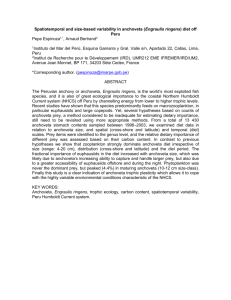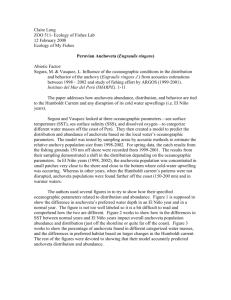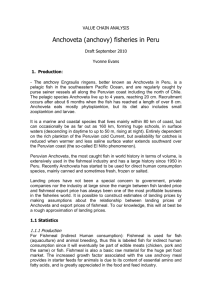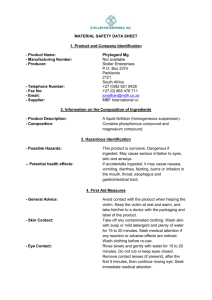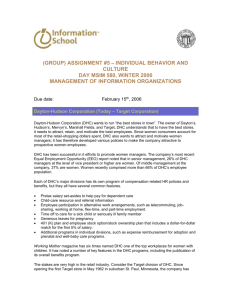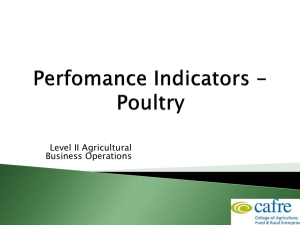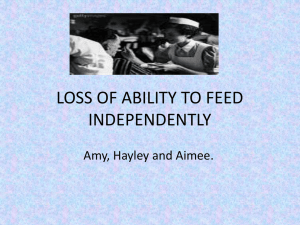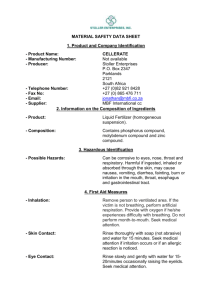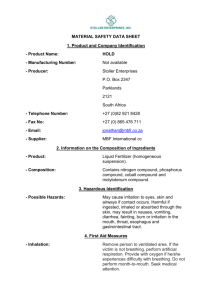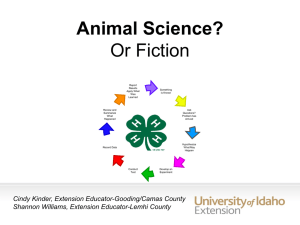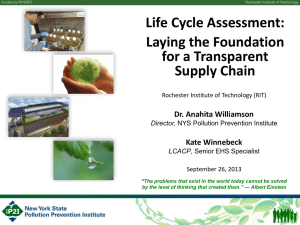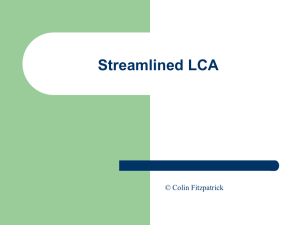Sustainability of the Peruvian anchoveta
advertisement
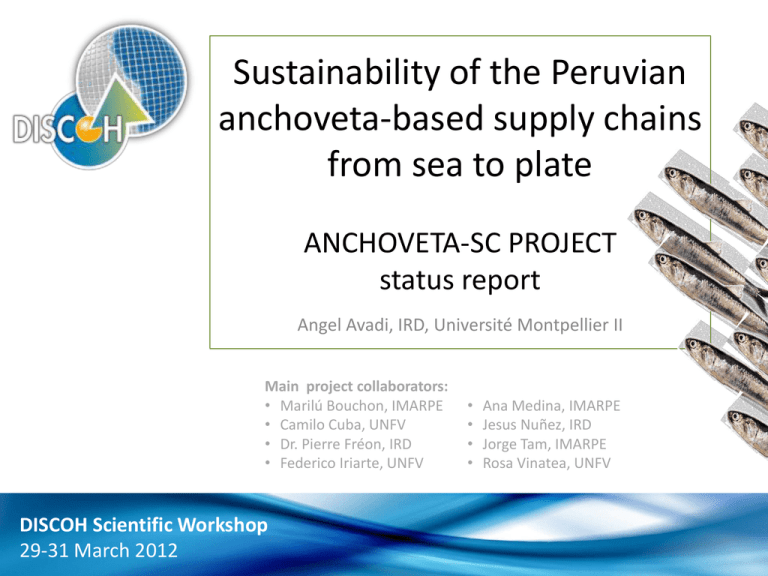
Sustainability of the Peruvian anchoveta-based supply chains from sea to plate ANCHOVETA-SC PROJECT status report Angel Avadi, IRD, Université Montpellier II Main project collaborators: • Marilú Bouchon, IMARPE • Camilo Cuba, UNFV • Dr. Pierre Fréon, IRD • Federico Iriarte, UNFV DISCOH Scientific Workshop 29-31 March 2012 • • • • Ana Medina, IMARPE Jesus Nuñez, IRD Jorge Tam, IMARPE Rosa Vinatea, UNFV 1 Outline 1. 2. The ANCHOVETA-SC project Supply chain modelling and evaluation – – 3. Modelling Sustainability indicators Initial LCA results 2 ANCHOVETA-SC • • • • • Project financed by IRD and project partners Coordinator: Pierre Fréon, IRD Location: Peru Duration: 4 years (01.2010 - 12-2013) Theme: Environmental and socio-economic assessment of major international supply chains consuming Peruvian anchoveta (aligned to WP5 DISCOH) • Outputs: – Sustainability assessment – Policy and sustainability suggestions – PhD thesis (plus other theses) 3 Focus 1. Characterisation of biophisical flows along the supply chains (SC) – 2. 3. DHC Marine Ecosystem Extraction Transformation Aquaculture Featuring ecosystem-SC interactions Comparison of scenarios based on different fishing intensities and “fate” of landings (DHC vs IHC) Harvest • Anchoveta catches • Predators catches • Catches for DHC or IHC IHC Fate • Final product Sustainability comparison of chains/scenarios based upon: – – – – – Energy performance Environmental impacts (LCA) Seafood-specific impact categories Nutritional value Selected socio-economic indicators 4 1) Simplified SC diagram Inputs Ecosystem dynamics Anchoveta, predators Inputs DHC processing Canned, cured, frozen Emissions Consumption Fisheries Emissions Inputs Anchoveta Inputs (including crops) Inputs Reduction Aquafeed Aquaculture Emissions Emissions Emissions Chinese finfish? European salmon? Shrimp? 5 Modelling ecosystem-SC interactions Ecopath with Ecosym Trophic model Umberto Material and energy flow model 6 2) Scenarios and 3) Indicators Harvest Fate Indicators rationale • Status quo (maximum anchoveta stock exploitation) Status quo (1-2% DHC) Status quo (maximum anchoveta stock exploitation) Increase in DHC (10-15% DHC) – – – – • Diversification (reduction of anchoveta catches + increase of predator catches) Mixed model with anchoveta DHC/IHC and anchoveta predators DHC To compare feed ingredients, feed formulations and seafood products: Gross energy content (MJ/kg) Edible protein Energy Return On Investment (%) Biotic Resource Use (g C/kg) Ecological Footprint (ha/t) To compare intermediate and final seafood products, and competing supply chains: – – LCA impact categories Socio-economic indicators (to be defined) 7 LCAs carried out • Two fishmeal plants: – a conventional one producing only Fair Average Quality (FAQ) fishmeal and using mainly heavy fuel as energy source – a more modern steam plant producing both FAQ and prime quality fishmeal and using both heavy fuel and natural gas • Detailed inventories of industrial anchoveta fleet under processing – preliminary LCA of representative “average“ 395 m3 vessel category • Two aquafeed plants (Iquitos) – A pilot facility and a working commercial facility • One aquaculture farm (Iquitos) – Peruvian Amazonian species 8 Iquitos Colossoma farm • Colossoma macropomum (Gamitana), a large Amazonian fish • Farm: 30 ha, converted from rain forest, 11.2 ha of ponds (no wastewater treatment), production: 100 t/a, feed: 150 t/a 9 Network: Colossoma farm 10 Fossil depletion Metal depletion Climate change Human Health Human toxicity Particulate matter formation Natural land transformation Climate change Ecosystems Agricultural land occupation Ionising radiation Terrestrial ecotoxicity Urban land occupation Ozone depletion Photochemical oxidant formation Terrestrial acidification Freshwater eutrophication Freshwater ecotoxicity Marine ecotoxicity Characterisation: Colossoma farm • Main impact contributors: feed and rain forest transformation FRY 11 Iquitos Aquafeed plants • 2 plants visited: – 30 t/a IIAP plant – 8 t/m commercial plant (competing with Purina, etc.) • < 6% Peruvian fishmeal content in feeds • > 33% Bolivian soymeal content • > 45% local cornmeal content 12 Network: Aquafeed plant (8 t/m) 13 Fossil depletion Metal depletion Climate change Human Health Human toxicity Particulate matter formation Natural land transformation Climate change Ecosystems Agricultural land occupation Ionising radiation Terrestrial ecotoxicity Urban land occupation Ozone depletion Photochemical oxidant formation Terrestrial acidification Freshwater eutrophication Freshwater ecotoxicity Marine ecotoxicity Characterisation: Aquafeed plant • Main impact contributor: use phase LCA FISHMEAL PLANT 14 Fossil depletion Metal depletion Climate change Human Health Human toxicity Particulate matter formation Natural land transformation Climate change Ecosystems Agricultural land occupation Ionising radiation Terrestrial ecotoxicity Urban land occupation Ozone depletion Photochemical oxidant formation Terrestrial acidification Freshwater eutrophication Freshwater ecotoxicity Marine ecotoxicity Aquafeed plant use phase • Impact contributors in use phase: – oil-powered electricity – feed ingredients, mainly Bolivian soymeal (due to clearcutting in Bolivia) 15 Network: Hypothetical trout feed plant (43% fishmeal) 16 Comparison of feed plants 17 Network: Fishing vessel 395 m3 18 Design remarks • Key aquaculture products haven’t been characterised for Peruvian conditions – E.g. Peruvian rice and corn. – Proxies were used and adaptations introduced when possible (e.g. Bolivian soymeal adapted from Brazilian) • Key industrial products haven’t been characterised, yet it’s composition is known/estimated – E.g. electric and combustion engines 19 LCA results • Construction and maintenance of (reduction, feed) plants contributes negligibly • Fuel use is the main contributor to impacts in all activities (fishing, reduction, feed processing) • Feed provision is the main contributor to impacts in extensive Peruvian aquaculture • The sourcing of feed ingredients is a critical factor for associated environmental impacts of feeds – E.g. Brazilian soymeal performing much worst than Bolivian one, due to clear cutting of rain forest vs. of shrublands. 20 Further (ongoing) work • EwE scenarios definition and integration with Umberto • Selection of and data gathering for socio-economic indicators • Statistical processing of fleet inventories and comprehensive LCA of fleet categories • Further LCAs: – Canning, curing and freezing plants – Carnivore fish and shrimp aquaculture farms • Gathering supply chains operative data and LCIs – Background processes for provision of feed ingredients – Published LCI/LCA data must be recalculated to ensure consistency 21 Gracias por su atención… Preguntas, comentarios? 22
